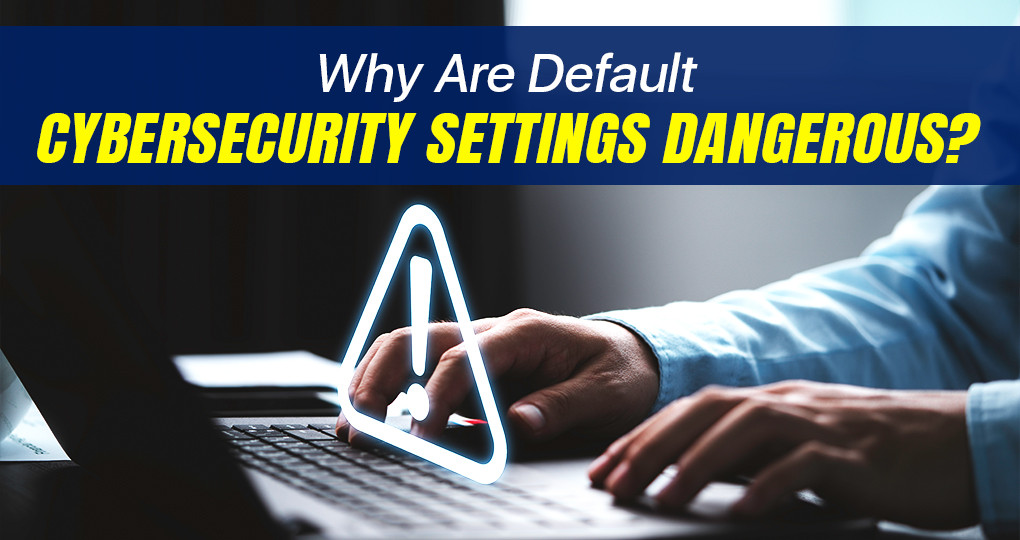General Information: (833) 775-1577


We all rely on our devices and online services to keep us safe and secure. However, many of us might not realize that the default cybersecurity settings on our devices and applications can put us at risk. It’s essential for you to understand why these default settings can be dangerous and what you can do to protect your data.
One might assume that manufacturers and software developers have your best interests in mind when setting up security defaults. Unfortunately, this isn’t always the case. The primary concern for these companies is often ease of use and widespread adoption of their products. As a result, security can take a backseat, with default settings prioritizing user convenience over privacy and protection.
Moreover, cybercriminals are well aware of these standard security settings. With everyone using the same default configurations, it becomes easier for attackers to find and exploit vulnerabilities. By not customizing your security settings, you inadvertently make it simpler for hackers to gain access to your personal information and devices.
In a nutshell? Because greater security often means less convenience—albeit, in small ways. Regardless, when it comes to products like Windows 10, the priority is usually to enhance the user experience, rather than configure the best security settings possible.
Here’s an example—when it comes to Wi-Fi connectivity settings, would you prioritize security or convenience? On one hand, it’s much more convenient to users if the device in question is configured to automatically connect to open and available Wi-Fi hot spots. But that’s not very secure, is it?
That’s why it’s your responsibility to make up the difference if you actually want to maintain a higher level of security.
Default cybersecurity settings are the standard, pre-configured security measures that come with a software or device. They are designed to provide a basic level of protection and privacy as soon as it is operational. You put them in place because they are easy to use and require minimal effort from the user.
However, you must recognize that these default settings may not always be sufficient in addressing the different security threats you face on a daily basis. It is your responsibility to assess and adjust your cybersecurity settings to enhance your overall protection.
Here are some common examples of default cybersecurity settings you often encounter:
While keeping the default cybersecurity settings in place is convenient, it is essential for you to take the time to review them and make any necessary adjustments based on your specific security needs. This proactive approach will help you mitigate the risks associated with relying solely on default settings.
Many times, you don’t realize that the default settings of a cybersecurity system can be a potential risk. Let’s dive into some of these and understand how they can be harmful.
When you use default settings, you provide a comfortable zone for hackers to operate. They are familiar with these settings, making it relatively easier to exploit the system. Moreover, default configurations often leave open ports, creating a gateway for cybercriminals to enter. By customizing your configuration, you can close these loopholes and make it more challenging for unauthorized entities to break in.
Default settings are designed to cater to a wide range of users and environments, which means they might not be suitable for your specific needs. When you tailor your cybersecurity measures according to your requirements, it allows you to address potential threats specific to your work or personal use. For instance, some industries may require additional security layers due to sensitive information or strict regulations. Adjusting settings as per your situation delivers a more targeted defense against potential risks.
To summarize, while default cybersecurity configurations may initially seem satisfactory, they can pose serious threats if left unchanged. Customizing settings and creating a robust, personalized cybersecurity strategy are essential steps to protect yourself in an increasingly sophisticated digital landscape.
The importance of updating default cybersecurity settings has never been greater. By making these necessary changes, you can significantly enhance your protection and personalize your security measures to better suit your needs.
There’s no denying that innovations in technology have drastically improved your lives. However, cybercriminals are constantly adapting and finding ways to exploit vulnerabilities in your devices and networks. To protect your data, you must actively stay a step ahead by adjusting default security configurations.
Every individual and organization has unique security needs, and it’s important to recognize that default settings may not provide adequate coverage. By taking the time to personalize your cybersecurity measures, you can effectively address the specific risks that you face.
Using default settings can lull us into a false sense of security, thinking that your systems are safe when in reality, they might be easily exploited by hackers. Attackers are well-aware of these default settings, making it easier for them to target systems and organizations that have not taken the time to implement better security measures.
To improve your cybersecurity, you have a few recommendations:
By following these recommendations, you can significantly reduce the likelihood of falling victim to cyber-attacks. It’s essential to acknowledge and address the dangers of default cybersecurity settings and take proactive steps to safeguard your digital assets and sensitive information.